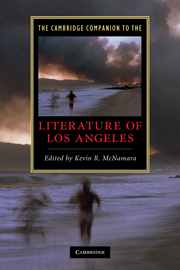Book contents
- Frontmatter
- Introduction: landmarks
- 1 The literature of the Californios
- 2 The Anglo invention of Los Angeles
- 3 LA fiction through mid-century
- 4 British expatriates and German exiles in 1930s-1940s Los Angeles
- 5 Postwar Los Angeles: suburban Eden and the fall into history
- 6 Los Angeles and the African-American literary imagination
- 7 Pacific Rim city: Asian-American and Latino literature
- 8 The literature of urban rebellion
- 9 City of sleuths
- 10 Los Angeles’ science fiction futures
- 11 Hollywood fictions
- 12 The Southland on screen
- 13 Scenes and movements in Southern California poetry
- 14 Surf, sagebrush, and cement rivers: Reimagining nature in Los Angeles
- 15 Essaying Los Angeles
- Guide to further reading
- Index
11 - Hollywood fictions
Published online by Cambridge University Press: 28 May 2010
- Frontmatter
- Introduction: landmarks
- 1 The literature of the Californios
- 2 The Anglo invention of Los Angeles
- 3 LA fiction through mid-century
- 4 British expatriates and German exiles in 1930s-1940s Los Angeles
- 5 Postwar Los Angeles: suburban Eden and the fall into history
- 6 Los Angeles and the African-American literary imagination
- 7 Pacific Rim city: Asian-American and Latino literature
- 8 The literature of urban rebellion
- 9 City of sleuths
- 10 Los Angeles’ science fiction futures
- 11 Hollywood fictions
- 12 The Southland on screen
- 13 Scenes and movements in Southern California poetry
- 14 Surf, sagebrush, and cement rivers: Reimagining nature in Los Angeles
- 15 Essaying Los Angeles
- Guide to further reading
- Index
Summary
Near the end of Mel Brooks's Blazing Saddles (1974), a fight breaks out in a saloon. As the brawl escalates, a wall of the saloon is knocked down to reveal another movie being made, a high society musical in the Fred Astaire/Ginger Rogers vein. Soon hyper-masculine cowboys fight effeminate dancers in a clash of classic film genres. This scene reveals the basic theme of Hollywood-on-Hollywood movies: movies are not true-to-life; instead they conform to strict genre formulas to create their own “reality.” Movies about Hollywood are well known and popular. Films like Singin' in the Rain (Stanley Donen, 1952) and Sunset Boulevard (Billy Wilder, 1950) share Blazing Saddles's delight in making viewers feel like insiders in the know about moviemaking. Even when there is an apparent critique of the film industry, it isn't genuine. At a silent film premiere, Gene Kelly's character is interviewed and delivers a stereotypical high-art story of his rise to fame that is undercut by the visual images of a child of the urban ghetto dancing in saloons and pool halls and then working as a stuntman before chancing into a starring role. The silent era, the film strongly implies, was a fake and elitist era but the new Hollywood of the sound era allows for genuine stories about real people. Similarly, Sunset Boulevard is brutally critical of the narcissism that characterizes the silent studio's star system. Norma Desmond now lives in a delusional world because she was ultimately nothing but the creation of the studios. While the silent era was unwittingly comical in Singin' in the Rain, here it is grotesque, but for the same reason. More recent films about Hollywood like the Coen brothers' Barton Fink (1991) and Robert Altman's The Player (1992) are certainly more genuinely critical of the film industry, only celebrating Hollywood's influence on culture in ironic and black comedic ways.
- Type
- Chapter
- Information
- The Cambridge Companion to the Literature of Los Angeles , pp. 135 - 144Publisher: Cambridge University PressPrint publication year: 2010

